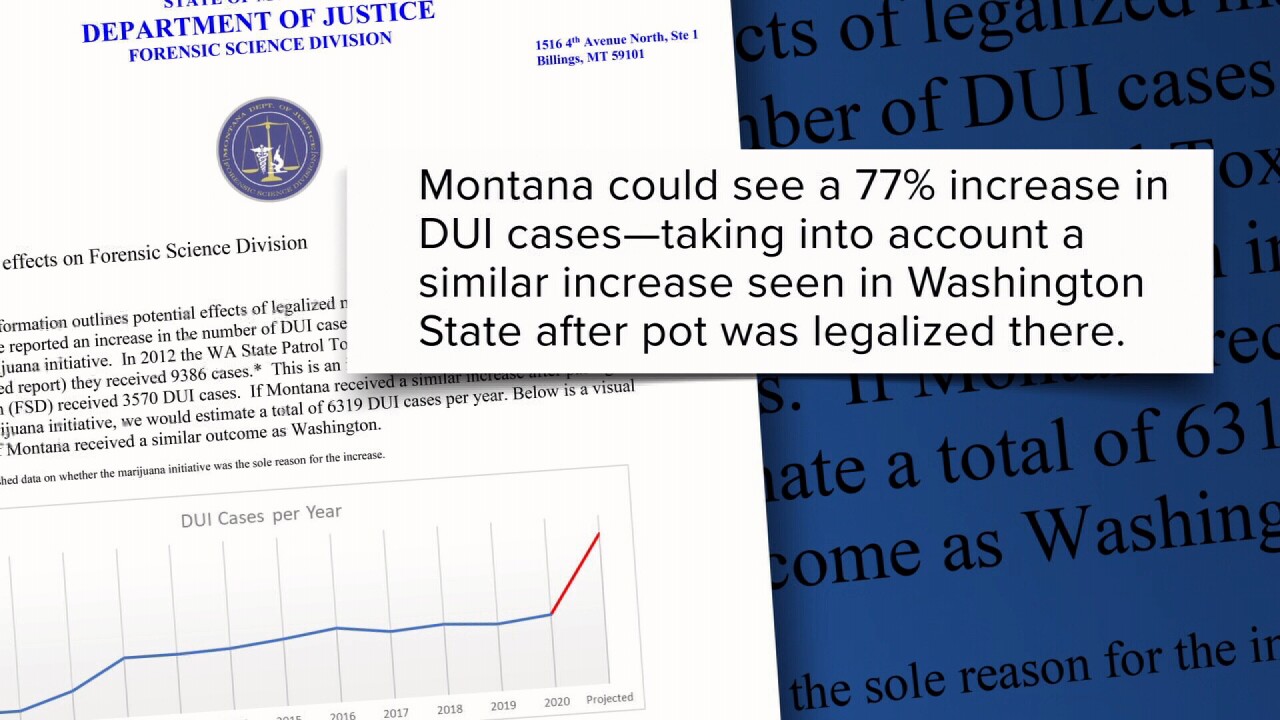BILLINGS — BILLINGS - As marijuana becomes legal in Montana with certain guidelines, there’s new concern among law enforcement roughly one month since the measure took hold. That’s because in a state already plagued by a drunk driving epidemic, new projections coming from the Montana Department of Justice show that DUI’s could increase due to marijuana use.
But that’s not the only concern. Officials working in Montana's justice system believe the measure was passed with gaping holes that ultimately will have to be addressed and ironed out by the Montana legislature before retail shops are set to open in the fall of 2021.
Driving while high is still illegal
On a brisk winter morning in January, Billings Police Officer Eric Schnelbach is parked on the side of Poly Drive, watching as cars drive by.

“I was working this school zone here and just looking for speeders,” said Schnelbach.
He says usually his work consists of catching the most common offenses, those who are running red lights or crashes, but on this day he caught a speeder going too fast through a school zone.
“He admitted to smoking (marijuana), just before driving,” Schnelbach said.
He’s a member of a specialized traffic enforcement team, trained to handle a variety of enforcement scenarios. That morning, Schnelbach pulled over a driver allegedly under the influence of marijuana.
Officers look for various things when it comes to drivers under the influence. According to Schnelbach, there was an odor of marijuana, bloodshot eyes, and several other observations similar to alcohol DUIs.
“He kind of started to realize that maybe he was impaired,” said Schnelbach. “So I guess it's a big awareness issue with people.”

An outline of the new measure
The voter approved measure went into effect on Jan. 1 making it no longer illegal for Montanans to use marijuana for recreational use, under guidelines.
Montanans over the age of 21 can possess an ounce of marijuana and own four plants.
The legalization was approved by Montana voters, who voted in favor of two measures in the November 2020 election. Constitutional Initiative 118 (CI-118) amended the state constitution to allow the Legislature or voters to set the age at which adults are allowed to possess and consume marijuana, and Initiative 190 (I-190) legalized the sale and possession of limited amounts of marijuana and levies a 20 percent tax on the sale of non-medical marijuana in Montana.
It also allows people serving a sentence for an act now legal to apply for re-sentencing or an expungement of a conviction and prohibits the advertising of marijuana and related products.
However, driving under the influence of marijuana remains illegal and carries the same penalties as Montana’s existing DUI laws. Officers will use a field sobriety test to drivers suspected of driving under the influence of pot, just as they would alcohol. Marijuana is measured in nanograms rather than blood alcohol content with five nanogram considered over the legal limit, according to Schnelbach.
Currently, officers in Yellowstone County are being trained on the new recreational marijuana measure, carrying with them an one-page field guide to cite which part of the law they may come in contact with if they suspect illegal behavior.
Why some say DUIs could increase
However, when it comes time to prosecute illegal activity associated marijuana use, that’s where things get complicated, according to Yellowstone County Attorney Scott Twito.
“There are some gaping holes in this initiative that are already causing concern,” said Twito.
Twito says his office is prepared for a surge in DUI cases associated with marijuana.
“Once it gets up and going, we're looking at 2,700 more DUIs per year statewide,” said Twito, "which is a huge number, if it comes close to that. Even less than that would be a lot for local law enforcement agencies to take on. “

A study done by the Montana Department of Justice in conjunction with the State Division of Forensics says Montana could see a 77 percent increase in DUI cases, considering a similar change seen in Washington state after marijuana became legalized there.
“Purely from a resource perspective, despite what people think, I mean it is going to lead to an increase in DUI events,” said Twito.
And although Twito says Yellowstone County is prepared to take on any uptick in cases that may come from illegal marijuana offenses, he says it’s the taxpayer who will likely foot the bill.
“That takes resources. That takes officers. That takes prosecutors. I’ve got to put prosecutors in courtrooms,” he said.
But DUIs are just one part of the inconsistencies that Twito sees in the recreational marijuana measure.
“It’s not even a penalty right now for someone over the age of 21 to give their marijuana to someone over the age of 18,” he said.
He also says the new measure doesn’t allow for smoking in public, but officers aren’t allowed to confiscate the marijuana if someone is caught doing so. Also, officers are not equipped with scales for measure the quantity of marijuana in someone’s possession to make sure it's within the legal limit.
“I don't know if you can tell the difference, 1.8 ounces two ounces. I can't,” said Twito. “So again, those are just silly things that we'll have to figure out.”
He’s hoping the legislature can iron out those inconsistencies so that the burden to interpret the law doesn’t fall on officers in the field.
A study done by the Journal of the American Medical Association took a look at how the legalization of marijuana impacted DUIs in states where it’s been a law for years; Colorado and Washington specifically.
The study found that since marijuana became legal in Colorado in 2014, road fatalities related to DUIs have increased by an additional 75 deaths a year on average.

However, the same study showed traffic related deaths remained relatively the stable in Washington state.

Why advocates remain confident in the measure
Still, advocates of Montana’s voter-approved recreational marijuana measure say there’s a reason the initiative passed in Montana; people want marijuana legal.
“It's pretty hypocritical for us as a society to say yes to alcohol as much as we do, without saying also yes if you choose to consume marijuana,” said Pepper Petersen, who is president of the Montana Cannabis Guild.

Petersen is currently lobbying the legislature during this winter session.
“We made some recommendations in the initiative and we hope the spirit of those carries through to the legislature,” he said.
He says the measure was designed to allow local governments the option to spend some portion of the marijuana tax dollars.
“I don’t think the problem with marijuana is ever going to reach the proportions that it has with alcohol,” he said. “And so I think that most of these concerns are probably overblown. Police just don't want to deal with another problem, and you know that's understandable.”
But funding from revenue could help in a big way.
Petersen says ultimately jurisdictions could end up using tax money to help offset the cost to combat illegal use by funneling revenue into funds to support local law enforcement.
“You know, a false dichotomy is sometimes drawn that the people who support marijuana legalization don't support safe communities,” he said. “That's just false. I think most of the people I know that are marijuana consumers are good citizens and good people.”
While research done by the University of Montana has shown that Montana’s new recreational marijuana measure could bring in as much as $50 million a year, Petersen says new numbers from 2020 sales in medical marijuana show an interesting comparison.
Montana’s seen over $100 million in medical marijuana sales in the first three quarters of 2020, something Petersen says will likely amount to over $130 million when the fourth quarter of the year is factored in.

He says marijuana supporters not only are in favor of safe communities but are also in favor of using revenue to offset any potential harm.
“You know, we have gambling in Montana, we have alcohol in Montana. We have things that adults can do that children can’t do, and we want to keep it that way.”
But when it comes to driving under the influence of marijuana, Petersen says violators will get busted.
“We encourage the police. We want to make sure those resources are available so they can go out there and you know make sure our streets safe, and make sure that we continue to have the quality of life we have in our communities,” said Petersen.
Back on the streets where officers deal with its either legal or illegal use, Schnelbach says just like alcohol sometimes it’s hard for people to know their limit.

“There's been studies that show impairment up to 24 hours after ingesting marijuana,” said Schnelbach. “And it all just depends on how much they ingest and how they ingest it.”
He wants drivers to know that while marijuana is now legal in Montana, it’s still illegal to drive under the influence.
He believes dangers can still lurk through use, especially when he’s watching for illegal activity in a school zone on a weekday morning.
“The small differences it makes in someone's body could be the matter of a kid’s life in a school zone,” he said. “Their ability to react.”
Montanans shouldn’t expect to be able to immediately buy marijuana at a retail outlet, unless they have a medical card.
The sections allowing recreational sales won’t take effect until at least October 2021, and current dispensaries are still limited to serving only registered patients.




